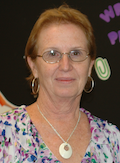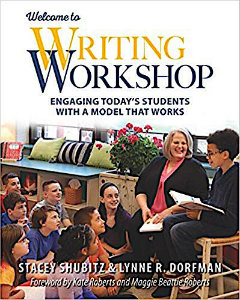How Writing Workshop Can Engage Students
Welcome to Writing Workshop: Engaging Today’s Students with a Model That Works
By Stacey Shubitz and Lynne R. Dorfman
(Stenhouse, 2019 – Learn more)
 Reviewed by Linda Biondi
Reviewed by Linda Biondi
I had tears in my eyes as I began to read Welcome to Writing Workshop: Engaging Today’s Students with a Model That Works by Stacey Shubitz and Lynne R. Dorfman. My first thought was “This is the way writing workshop should be taught! Putting our students first!” My next thought was “Where was this book years ago?”
 As teachers, we know that books have the potential to open minds to many possibilities. Books can swell our hearts, plant seeds for thought, inspire us, motivate us, change lives. Shubitz and Dorfman have outdone themselves. They have written a book that will inspire teachers for a generation to come.
As teachers, we know that books have the potential to open minds to many possibilities. Books can swell our hearts, plant seeds for thought, inspire us, motivate us, change lives. Shubitz and Dorfman have outdone themselves. They have written a book that will inspire teachers for a generation to come.
Teaching writing workshop was one of my favorite things to do as an elementary school teacher. I loved when the students begged for more time to write. I’ll never forget the time that Stephen took home his Writers Notebook and asked his parents and little sister to write in their own Writers Notebook (true story).
This literacy guide will enable educators to teach Writing Workshop in a way that will inspire students to have that innate desire to write. It can also empower teachers to help colleagues teach Writing Workshop “the right way.”
Research, experience and insight
Each page in this marvelous book is jam-packed with words of wisdom collected from years of experience, data, research and insight. “Building a writing community starts in September, but sustaining the community is a yearlong effort.” (p. 41) Absolutely! But how do you do it when you need to complete your SGO (Student Growth Objective), write lesson plans, monitor standardized testing, attend workshops, reflect on your teaching, gather data, and deal with a severe lack of sleep?
What exactly is Writing Workshop? “The structure for writing workshop is simple: it is student centered and based on the belief that students become successful writers when they write frequently for extended periods of time, and on topics of their choice.”
The book’s ten sections
• What writing workshop is all about and the verbiage associated with it.
• What writing workshop looks like: structure, environment, furniture, seating, anchor charts.
• How to build a community of writers.
• Procedures and routines.
• How to manage whole class instruction.
• How to build independent writing time into your daily schedule.
• Conferring to individualize instruction, build community and set goals.
• Types of small group instruction and how they work.
• Sharing time in the workshop model.
• How instruction in grammar, conventions, and spelling works within the workshop model.
Of particular note is the authors’ point that establishing a writing workshop begins with what we do to make our students feel safe and secure in the classroom. Think about it. You can’t share your world and inner emotions, and have others look into your writer’s soul, unless you feel comfortable and secure. Shubitz and Dorfman share strategies that invite students to discover who they are as writers and learn ways to improve as a listener inside the workshop model.
I loved the strategies included throughout such as “Introduce them to many genres and a wide range of mentor texts.” That range might include:
- Poems
- Song lyrics, book and movie reviews, how-to manuals
- Advertisements
- Travel guides
- Letters
- Web pages
- Riddles
- Comic strips
- Birthday cards (and other celebratory cards)
- Notes from friends
Multimedia ideas from teachers
It’s not just the authors who share their research, strategies, and thoughts. Many of the ideas are supported by teachers who are currently teaching writing and who share their joys and frustrations. Practical ideas come from teachers who collaborate to be the best writing teachers that they can be.
Included throughout the book is access to short video clips from teachers who want to help you as you continue your search to inspire young writers. (For example, The Social-Emotional Environment Begins with the Teacher, Frank Murphy, sixth grade teacher, p. 24.)
You can’t imagine the number of photos, anchor charts, and forms that are interspersed throughout that will inspire you. They accompany the 206 pages of information written in a style that will make you feel as if you are talking to a colleague about the teaching of writing. It’s like sitting in on a conversation with a friendly, knowledgeable mentor.
We want our students to have an innate desire to write. When our students were small, they were so excited to show off their writing, even if it was scribbles. They wrote everywhere and anywhere. We want that passion to come back and stay in their lives.
I never thought I’d recommend that the reader of a professional book make sure that a smartphone or tablet was sitting next to them, but with this book, I definitely would recommend it. Stop, look, and listen. The book is jammed full of QR codes and internet links of online guides that you can download, video clips of teachers in action, and freebies such as downloadable examples of all types of writing.
Fresh ideas based in accepted practices
Sometimes you think that anything and everything that can be said about writing workshop has already been written, but this is not true. This book has reaffirmed what I knew, opened my eyes to new ideas, supported important theories about writing, and made me want to learn more about the teaching of writing.
This book grants the teacher reader the power to become a teacher of writing and also allows the teacher to develop research-based lessons that build on their students’ needs and not a scripted curriculum. It’s a book that will have many dog-eared pages, post-its sticking out, and highlighted sections!
It’s a book that I will definitely be recommending to administrators, college professors, and colleagues (upper grades can scaffold the work for older students with relative ease). Welcome to Writing Workshop: Engaging Today’s Students with a Model That Works is going to be a best seller, if it isn’t already. It is the writing teacher’s new best friend.
_________________________
After teaching fourth graders for many years, Linda Biondi is supervising preservice and student teachers at The College of New Jersey and Rider University. Last summer she co-facilitated a week-long writing institute in conjunction with the National Writing Project at Rider University. She volunteers for two service organizations: Homefront and Dress for Success of Central New Jersey – both have a mission to end poverty and homelessness. The mission of Dress for Success is to empower women to achieve through economic independence.


































